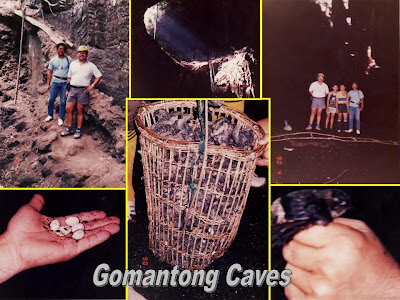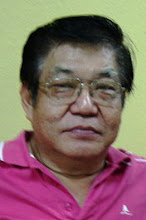



 I like Sandakan after my transfer to Morisem Estate in December 1988. The out-going Manager, Saw See Hong, picked me up from Sandakan airport on 8 December 1988. That was my first trip to Sabah, the Land Below The Wind, in East Malaysia. I was surprised when I was told that Sandakan was once nick-named “Little Hong Kong”. The common Chinese dialect in this town is Hakka and not Cantonese and it seems that over 98% of the Chinese Malaysians in Sabah speak Hakka dialect. Later, my Sandakan friends explained to me that many of the earlier Chinese settlers actually came to Sandakan from Guangdong Province via Hong Kong. Anyway, I felt at home in Sandakan and it was easy for me to make new friends since I am also a Hakka. My late father came from Da Bu in Guangdong Province and settled down in Kuala Lipis, Pahang, West Malaysia.
I like Sandakan after my transfer to Morisem Estate in December 1988. The out-going Manager, Saw See Hong, picked me up from Sandakan airport on 8 December 1988. That was my first trip to Sabah, the Land Below The Wind, in East Malaysia. I was surprised when I was told that Sandakan was once nick-named “Little Hong Kong”. The common Chinese dialect in this town is Hakka and not Cantonese and it seems that over 98% of the Chinese Malaysians in Sabah speak Hakka dialect. Later, my Sandakan friends explained to me that many of the earlier Chinese settlers actually came to Sandakan from Guangdong Province via Hong Kong. Anyway, I felt at home in Sandakan and it was easy for me to make new friends since I am also a Hakka. My late father came from Da Bu in Guangdong Province and settled down in Kuala Lipis, Pahang, West Malaysia.To get into Morisem Estate, we had to travel to Sukau, a small village by the bank of Kinabatangan River. Then we had to cross the river on a barge towed by the company’s tugboat, powered by a 200HP Yanmar engine. We called it "Morisem Ferry". In the late 1980s, the road conditions from Sandakan to Sukau after the Mile 32 Check Point used to be very bad after rains, being muddy, soggy and very slippery for vehicles to travel even after engaging the 4WD (four wheels drive). Most stretches along the main trunk road were not tarred but only surfaced with round river pebbles. That’s why we preferred to stay back in the estate most weekends during the monsoon seasons.
Travelling along the Kinabatangan River on "Morisem Ferry" particularly in the very late afternoons was always full of anticipation and eagerness as well as excitement when we were lucky to see the long- nosed Proboscis monkeys on trees of the mangroves near the river banks. With a big dangling bulbous nose and its pot-belly and sitting on a branch with its long tail (about the same length as its body) hanging down, from far it was previously mistaken as a “Dutchman”, thus it was called ‘monyet Blenda’ in Bahasa Indonesia/Malaysia. Nevertheless, the official Indonesian name for “Dutch monkey” is Bakantan.
It was David Soo who took me to Labuk Bay Proboscis Sanctuary located at the center of the mangrove forest along the coastal land near Kampong Samawang within an oil palm estate to have a close watch of the Proboscis monkeys swinging and leaping from tree to tree during the feeding time. I was in Sandakan to visit his workshop installing HIAB crane to farm tractor. My 2nd trip to the sanctuary was accompanied by Mr. Lee Min Khin when we travelled to Sandakan one early Sunday morning after completed my visit to the plantation he managed.
We were so amazed when one local staff told us that there were at least 3 groups of Proboscis monkeys in the sanctuary. “That’s Romeo,” he pointed to a big adult male accompanied by a bunch of females and the young ones having small upturned noses. “Caesar’s there,” he showed us another adult male among other group of females and juveniles. Then he told us that the latecomers were all males forming the bachelor group before acquiring their own harems. He carried on telling us that a ‘challenger’ would emerge from the bachelors to fight the adult male. If it lost the fight, it would go back to the bachelor group but if it won the fight, it would replace the loser as ‘alpha male’. The poor loser had to leave to somewhere secluded and isolate itself and would never show up again.
One day Simon, our trainee Assistant in Morisem Estate, found a strayed young orangutan in his division at the jungle edge boundary. After nourishing it for few days, I told him to surrender it to Sepilok Orangutan Rehabilitation Centre located within the Kabili-Sepilok Forest Reserve, about 25 kilometers west of Sandakan. When my family visited me during the school holidays in 1990, I brought them to the orangutan sanctuary in Sepilok. My wife and my young children were overjoyed with lot of laughter seeing the playful orangutans swing in from the jungle trees on to the feed platform during the feeding time. In this rehabilitation centre the young orangutans, mainly orphaned, are raised and trained for survival in the wild environment and will be eventually released back to the jungle when ready. It has become one of Sabah's top tourist attractions.
There was on occasion I saw an elephant crossing the logging track in front of us. At that time I was travelling in the vehicle of another planter, Chin Teng Nam. He quickly stopped his vehicle and turned off the engine. Since it was still quite a distance away, he did not want the running engine sound to disturb it or draw its attention. The big mammal flapping its ears and swiveling its trunk from side to side, turned its head towards the direction of the vehicle, hesitated for awhile, then walked slowly across the road into the jungle. However, I had never seen the elephants swimming across the Kinabatangan River, as told to us by Orang Sungai friends in Sukau. Nevertheless, there was a newspaper write up in Daily Express published on January 26, 2006, “Due to barriers formed by large rivers, large water channels, oil palm plantations and villages, the forests downstream of the Sandakan-Lahad Datu highway are divided into 15 fragmented patches. Borneo Pygmy elephants can only move between these patches by swimming across rivers, and walking through plantations and villages.” As a matter of interest to all, I have downloaded a photo of the ‘swimming elephants’ from the internet.
Not far from Sukau are the Gomantong Caves famous for bird’s nests. There are two caves, the Black Cave known as Simud Hitam Cave producing black bird’s nests and the White Cave known as Simud Puteh Cave producing the more valuable white bird’s nests. Besides swiftlets, bats are also among the resident creatures of the caves. Other birds such as serpent eagles, bat hawks and kingfishers can be seen outside the caves. One day I and Wong Tan Ho, our provision shop operator in Morisem Estate, went to have a look inside the Black Cave accompanied by our Sukau police chief. As we stepped into the cave, it was dark and smelly inside, and the entire floor of the cave was covered with guano of 3 – 4 meters deep. What amazed us was the erected long rattan ladders with poles and hanging ropes to collect the bird’s nests built by swiftlets right on top of the cave. We could imagine that the licensed harvesters of bird’s nests were highly skilled climbers and well rewarded for their hard earned take home pay.
Traditionally, Sandakan’s economy was heavily dependent on export of tropical timber. However, the once dominant timber industry is currently relatively small with increasing depletion of the natural forests and ecological efforts to save remaining natural rainforest areas. I used to see tugboats towing hundreds of timber logs tied to one and other floating above the water surface and also tugboats towing huge stockpile of timber logs on large barges along the Kinabatangan River going downstream towards the direction to Sandakan port.
Apparently Sandakan has become the top palm oil producer in Sabah and I am proud that I was one of the many planters working in the Kinabatangan areas in the late 80s. I also went back as a Planting Controller for plantation visits every now and then in 1995/2003. Over the years the well developed oil palm plantations and the palm oil mills belonged to IOI, IJM, PPB, and others big plantation companies have played the important role in bringing good revenues and enormous development to Sandakan. Those days the road condition was very bad and used to become soggy, wet and very slippery during the rainy seasons. Due to the frequent of vehicles bogged down on soft muddy road, the lorries carrying FFB (Fresh Fruit Bunches of oil palm) to palm oil mills left early in the mornings and returned to the plantations late in the evenings. That’s why we used to complain, “It’s not the distance that counts but the time of travelling that matters because of the very bad road condition.” I remember the road to Sukau was only surfaced with river pebbles and full of potholes and even sink holes here and there along the way. In those days CPO was also transported by specially fabricated barges along the Kinabatangan River.
I love the seafood in Sandakan and I remember there were so many eating places in this town. Most seafood restaurants were built on stilts and extend out to the sea. For seafood steamboat, we preferred Trig Hill Restaurant built on hill top, overlooking Sandakan town. We were able to have night view of Sandakan harbour and felt the cool air while eating the steamy seafood and drinking cold beer in the open air. To me, the best place to eat seafood Dim Sum(点心) was in Palm Garden, Hotel Sandakan. For breakfast, we could find many varieties of hawker’s foods in the old Fat Cat ‘makan’ shop located in Bandar Nam Tung, particularly the seafood noodles in preference of either, mee (麵),beehun (米粉) or hor fun (河粉)served with large tiger prawns, squid and shellfish. I also liked the Penang Char Kuey Teow (炒粿条)with fresh prawns. I even told the hawker why not change the name to Sandakan Char Kuey Teow? We also had buk kut teh(肉骨茶) in Bandar Nam Tung. There was one restaurant in Bandar Ramai Ramai specially cooked yellow wine chicken(黄酒鸡) for us on special request. The English Tea House (near the Rotary's Observation Pavilion) built on hill high above Sandakan should be the right place for afternoon tea, having time to relax and chatting with friends while looking over Sandakan town and the ocean.
My only regret was missing the chance to visit the Turtle Island, famously known as Pulau Siligan, to watch turtles lay eggs. I shall visit Sandakan again and this time will surely make a trip there.
Click on http://www.youtube.com/watch?v=aJEdjmIJ7yQ to watch and listen to this Sabah Hakka song. You'll like it.








